John Kerry, US President Joe Biden's recently resigned climate envoy, has great respect for climate science and swears by the scientific reports of the Intergovernmental Panel on Climate Change (IPCC), the scientific climate arm of the United Nations. In his many farewell speeches and interviews, he constantly stressed that ““Mathematics and Physics” The climate policy advocated by the Intergovernmental Panel on Climate Change is absolutely clear and irrefutable. We need to stop bickering, dragging our feet, and doing what science tells us. If not, unprecedented “planetary devastation” awaits us.
What the IPCC recommends is very clear: Anthropogenic emissions of carbon dioxide and other greenhouse gases must be reduced to zero by 2050 at the latest. This is the only way to limit “dangerous” global warming since the beginning of the industrial era to a safe degree of 1.5 degrees Celsius, the minimum in the 2015 Paris Agreement.
Clearly incorrect flag
The recipe may be obvious, but the science behind net zero by 2050 is patently incorrect. On the other hand, this flawed science forms the basis of the ambitious and far-reaching climate policy pursued by Western countries in particular. Led by the European Union, which aims to become the world's first climate-neutral continent with net-zero emissions by 2050. This is even enshrined in binding European climate law.
The biggest flaw in the science behind net zero is that it does not take into account the loss of carbon dioxide from the atmosphere due to absorption of carbon dioxide into the biosphere (growth of trees and plants) and into the oceans (dissolution in ocean water). . While this inclusion ensures that even today, with the enormous growth in emissions, half of annual emissions are counted towards the increase in carbon dioxide in the atmosphere. The other half settled in the biosphere and oceans. The uptake of carbon dioxide in the biosphere and oceans is of paramount importance for the carbon dioxide balance in the atmosphere and thus for temperature rise. To exclude this inclusion is a gross simplification that cannot be justified in any way.
Not taking into account natural uptake of CO2 is a direct consequence of the IPCC principle that global warming depends linearly on cumulative CO2 emissions since the beginning of the industrial period. This linear relationship holds for past global warming in which carbon dioxide emissions increased dramatically. But this relationship certainly does not apply in the future where carbon dioxide emissions decrease, even to completely zero, if it is up to supporters of a strict climate policy. The IPCC has made the fundamental mistake here of extending the past association between two variables (global warming and cumulative emissions) into the future, outside the area where that association is valid.
Fully consistent with the IPCC principle, global warming can be reduced by capping these cumulative emissions. According to the latest IPCC report 2021 (AR6), a total of 500 gigatonnes of carbon dioxide could be emitted as of January 1, 2020 to remain below one and a half degrees. Then the emissions end and end. From 2050 onwards, according to the Intergovernmental Panel on Climate Change, temperatures will continue to fluctuate around 1.5 degrees for many years to come. After all, carbon dioxide absorption through natural processes is not included in the IPCC.
There is no net zero in the Paris Agreement
The idea of returning annual net carbon dioxide emissions to net zero did not yet exist at the time of the Paris Agreement. Net zero is not mentioned anywhere in the agreement, not even in the vaguest terms. On the contrary, the text leaves no room for misunderstanding about how to achieve global warming goals: by reducing human emissions to a level corresponding to the absorption of carbon dioxide into the biosphere and oceans. This is literally stated in Article 4.1 of the Paris Agreement:…This is to achieve a balance between anthropogenic emissions by sources and greenhouse gas removal processes by sinks…'. Not a word of Spanish there.
The measured increase in atmospheric carbon dioxide since 1959, the year in which systematic measurements of atmospheric carbon dioxide concentrations began, can be excellently described by assuming that the pulse of atmospheric carbon dioxide emission due to uptake by the biosphere and oceans decays Significantly at a constant decay rate of about 2 percent per year. The process of CO2 decay is similar to the depreciation of a one-time cash donation in a piggy bank at constant annual inflation. Therefore, the value of this donation will decrease significantly. A decay rate of 2 percent per year is equivalent to an average residence time of carbon dioxide in the atmosphere of 50 years (1/0.02).
As long as annual emissions exceed the annual loss of carbon dioxide to the atmosphere through absorption in the biosphere and oceans, the concentration of carbon dioxide in the atmosphere will increase, and thus temperatures will also rise. This has been the case continuously since 1850 with emissions increasing dramatically. But if the emission rate drops to a constant level, the concentration of carbon dioxide in the atmosphere will stabilize at a certain level, and thus the temperature will also rise. In order for the temperature to rise by 1.5 degrees, emissions would need to be reduced to 26 gigatonnes per year.
The chart below shows the evolution of warming if the rate of emissions is reduced from more than 40 gigatonnes per year in 2025 to a steady rate of 26 gigatonnes per year in 2050 (orange) and net zero emissions in 2050 (gold). The graph also shows part of the historical warming due to the huge increase in emissions in the past (solid blue color) and future warming if emissions continue to grow significantly (dashed blue color).

Non-interference is not an option
The blue dashed curve shows the need to intervene on global carbon dioxide emissions. If emissions continue to grow significantly, temperature rise will approach 6 degrees by the end of this century. This may actually be the beginning of the “planetary devastation” that Kerry is talking about.
The orange curve shows what would happen if carbon dioxide emissions were reduced to 26 gigatonnes per year in the spirit of the Paris Agreement from 2025 to limit temperature rise to 1.5 degrees. The warming initially increases, then decreases and reaches a maximum of just below 1.7°C in 2045, after which a period of slow cooling begins towards one and a half degrees, which is the ultimate goal. At the end of this century, temperatures will still be slightly higher.
The golden curve of net zero emissions from 2050 onwards shows the same character: an initial increase, stabilizing to a maximum in 2035 of around 1.6°C, followed by a relatively rapid cooling to an eventual zero temperature rise, which is equivalent to an average Earth temperature. It has returned to pre-industrial levels. By the end of this century, warming had fallen to approximately 0.25°C, close to the level of warming in the 1960s.
The overriding message in the chart above is that current climate policies aimed at reducing net carbon to zero are (to put it mildly) unnecessarily restrictive and run counter to the spirit and letter of the Paris Agreement. With net emissions reaching zero by 2050, we are heading directly towards the climate of the Little Ice Age that prevailed before the industrial revolution.
This was not the intention of the designers and negotiators of the Paris Agreement, including then US Secretary of State John Kerry. As carbon dioxide emissions fall from the current level of more than 40 gigatonnes per year to 26 gigatonnes per year in 2050, “dangerous” global warming will be close to a 1.5 degree limit, fully consistent with the Paris Agreement.
The urgency of the global climate problem is much less urgent than IPCC scientists and their followers claim. The IPCC will not be able to avoid mistakes.”Mathematics and physicsBehind the current net zero climate policy. On the other hand, policymakers could start with a more realistic climate policy and adjust downward the current stringent climate targets.
Less money for climate policy
It is possible that the new Dutch government, which will advocate a less ideological and dogmatic climate policy, if the signs are not deceiving, will take the lead in Europe. This will require some effort because the idea of climate neutrality by 2050 has firmly established itself in the minds of policymakers and administrators in Brussels. But in the end, science will triumph over ideology, there is no doubt about that.
At the same time, the government would be wise to make progress on a more realistic climate policy by significantly tempering current overblown climate ambitions and allocating less money to them. The latter could be beneficial to other political intentions of the new government team.
Jack Haggort He holds a PhD in Physics from TU Delft. He worked as a researcher and consulting engineer in the oil and gas industry. From 1988 until his retirement in 2002, he was part-time professor of reservoir engineering at TU Delft.
Winya weekMade possible by voluntary paid subscriptions from readers, viewers and listeners. Are you already participating? You can donate to Winya Weekhere. Thank you!

“Total coffee specialist. Hardcore reader. Incurable music scholar. Web guru. Freelance troublemaker. Problem solver. Travel trailblazer.”







More Stories
GALA lacks a chapter on e-health
Weird beer can taste really good.
Planets contain much more water than previously thought